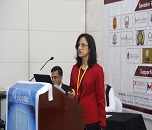Theme: Investigating the ongoing advances in Food Microbiology and Food Technology
Food Microbiology 2021
It is our great pleasure to warmly invite you to all of the great scientists, academicians, young researchers, Business delegates and students from all over the world to join the 15th International Conference on Food Microbiology (Food Microbiology Conference 2021) during June 27-28, 2021 in Frankfurt, Germany.
This conference provide a platform to share the new ideas and advancing technologies in the field of Food Microbiology and Food Technology. The objective of this Conference is to join the International Food science groups to investigate the key themes and difficulties that our field faces. The subject of this Conference is "Investigating the ongoing advances in Food Microbiology and Food Technology", which explore the ongoing headway rather it could be extended to all potential ways which will be useful in increasingly more development research in this arising field. As experts, researchers, and residents we need to cooperate to investigate the feasible outcomes and plan deliberately for collective development of our science, its valuable applications, and responsible practices. Food Technology can be utilized to advance so many facts of the world today. The use of Molecular Approaches in all parts of current Food science field. This conference also emphases on a wide-ranging variety of current research on microbes that have both beneficial and harmful effects on the safety and quality of foods and are thus a concern of public health.
This conference will focus on increasing challenges, new concepts and approaches presented by different aspects of food microbiology, going from worldwide and nearby/territorial issues in food hygiene and to food safety followed by the molecular approaches in all aspects of modern food microbiology.
This is the best chance to collaborate with members from the Food Microbiology associations, Food Biotechnology Organizations, Food Microbiology Societies, and Food Science Academicians.
It primarily impacts the advances in Food Microbiology and other technology in Food Sciences, just as for commencement of new appraisals and innovations and the adequacy of different administrative projects on Food Microbiology , share information, meet with present potential and prominent researchers, and get name acknowledgment at this two days occasion.
Benefits of Attending Food Microbiology 2021:
- All the abstract will be published in the international journals.
- Each abstract will be assigned with the unique DOI by Cross Ref.
- Earn CPD Credits as well as participation certificate by IOCM.
- Global Networking with the renowned researchers and scientists.
- Best Poster Competition as well as Young Researchers Award.
Why to attend the conference
Food Microbiology 2021 Conference is a multidisciplinary event with wide participation of members from around the world focused on exploring about microbiology research and its advances. This is your best possibility to reach the largest assembly of participants from microbiology community that is from different academics, microbiology institutes, medical groups, labs, related societies, associations and also from pharmaceutical, biomedical and medical device industries. This conference accomplish presentations, distribute information, meet with current and potential scientists, make a display with new clinical research developments, and receive name recognition at this 2-days event. World-renowned speakers and the most recent techniques, developments, the newest updates in Food microbiology are hallmarks of this conference.
Intended Audience:
- Researchers
- Microbiologists
- Food technicians
- Academicians
- Researchers
- Students (Post graduates, Doctorates)
- Food industries
- Private sectors
- Food Microbiology Societies
- Food Microbiology Associations
- Individuals subject matter in Food Microbiology, Biotechnology, Nanotechnology and Food related matters.
We are eager to invite experts together to one stage. Our aim is to advance the joint effort between specialists in these zones and glimmer novel thoughts that will additionally propel this field. The venue is ideal for advancing communication among speakers and participants.
Track 1 Food microbiology
Food microbiology is the study of the microorganisms causing food spoilage and contaminates the food. The pathogens or the microorganism that may cause disease especially if food is improperly cooked or stored. It incorporates microorganisms that have both useful and injurious impacts on food quality and safety and may therefore be of concern to public health. Preparation of food, including appropriate cooking, kills most microorganisms and infections in the food. However, toxins formed by contaminants may not be reason to change into non-toxic forms by heating or cooking the contaminated food. Temperature plays very vital role to control microbial growth. To ensure food safety some microbial test for pathogen and spoilage microorganisms is required. In this manner the risk of contamination under usual conditions can be examined and food contamination can be prevented.
- Microbiology of fermented foods and beverages
- Food mycology
- Predictive microbiology
- Microbial aspects of food spoilage and quality
- Industrial microbiology
- Nutritional availability in foods
- Applications of indicator organisms
- Factors affecting the growth of food micro-organisms
- Adoption of biofilms in food
Track 2 Microbiology of Food Fermentations
Fermentation technology refers to as the metabolic process which involves the use of microorganisms and enzymes for production of compounds which have application in the pharmaceutical, chemical and the food industry. Fermentation occurs in certain types of anaerobic bacteria, fungi, and yeast. The process of fermentation are valuable to the food and beverage industries, by conversion of sugars into ethanol, to produce alcoholic beverages, and yeast is used in the leavening of bread, and for the production of organic acids to flavor and preserve dairy and vegetable products. Fermentation is the ancient technology widely used in the preservation of food. It ensures to enhance the shelf life and microbiological safety of a food but may also make some foods more digestible and in the case of cassava fermentation reduces toxicity of the substrate. Lactic acid bacteria as its limited metabolic characteristics are involved in many fermentation processes of milk, meats, cereals and vegetables. Fermented foods are the food substrates used by edible microorganisms whose enzymes like proteases, amylases, and lipases which hydrolyze the polysaccharides, lipids, and proteins to make nontoxic products with aromas, flavors, and textures which is attractive to the human consumer. Fermentation plays vital roles in food processing: (1) Improvement of food substrates biologically with vitamins, protein, essential amino acids, and essential fatty acids; (2) a reduction in cooking times and fuel requirements; (3) preservation of substantial amounts of food through lactic acid, alcoholic, acetic acid, alkaline fermentations, and high salt fermentations; (4) Enrichment of the human dietary through development of a wide diversity of flavors, aromas, and textures in food.
- Lactic acid fermentation.
- Ethanol Fermentation/alcohol fermentation. ...
- Acetic acid fermentation
- Alkaline fermentations.
Track 3 Predictive Microbiology
Predictive microbiology is a depiction of the responses of microorganism's to particular environmental conditions such as temperature, pH and water activity. It uses the mathematical models (built with data from laboratory testing) and computer software which graphically describe these responses. Predictive microbiology provide the condensed knowledge of traditional microbiology combined with the disciplines of statistics, mathematics and information systems and technology to explain the microbial behavior to prevent the food spoilage as well as food-borne illnesses. The microbial growth and their survival or death in foods is determined by the properties of food (e.g., water activity and pH) and the storage conditions (e.g., temperature, relative humidity, and atmosphere). It describes the microbial behavior in different environments and helps us to understand and manage the ecology of food borne microorganisms. Predictive microbiology ensures that the behavior of the microorganism is reproducible and quantifiable by characterizing environmental factors. These factors control microbial viability (e.g. temp, aw, pH, organic acids) with assist in defining preventive controls (e.g. critical limits), help regulatory authorities to develop standards and help companies meet standards which Minimize microbiological testing and ensure the food safety and control. Some of the more regularly used models are listed below:
- Combase
- Pathogen modeling program
- Growth predictor and Perfringens predictor
- Sym’Previus (an integrated database and predictive software
Track 4 Current Trends and Research in Nutrition and Food Science
Food Science helps in the preparation of crude rural deliver into nourishment items that are sufficient for human utilization. A Food Scientist has what it takes important to change over these crude materials into the protected, appealing sustenance items and drinks accessible on our grocery store racks. Sustenance Scientists continually look to enhance existing systems by which new items are created, prepared, bundled, put away and transported.
Food Science is an energizing field of concentrate that applies sciences, for example, Chemistry, Biochemistry and Microbiology to find approaches to enhance the taste, nourishment and nature of the world's nourishment supply. You will likewise find out about nourishment conservation and preparing, sustenance examination, item improvement, sustenance bundling and the usage of sustenance quality and wellbeing frameworks.
Micro-organisms were used in industrial processes even before their existence was known. The production of fermented beverages and vinegar, and the leavening of bread are all traditional processes which have come down to us from time immemorial. The discovery of micro-organisms with their multiplicity of highly specific biochemical activities has stimulated a steady growth of industrial fermentation processes.
- Dairy Industry
- Meat Industry
- Health Food Industry
- Wine Industry
Track 5 Food Technology
Food is vital for people to support life. Food Science is a stream which manages the investigation of the physical, chemical and biological make up of food and food ingredients. The applied form of this science or innovation makes different branches like its selection, preservation, processing, packaging, distribution, and utilization of safe food. The commitment of food experts working in the field of food science and innovation by recent tools and procedures is enormous in the making of healthier food and ensuring constant and plentiful supply of food ingredients.
- Novel Food Engineering Technologies
- Automation of Food Industry
- Chemical Reaction and Kinetics of food components
- Computer Applications in Food Technology
- Gene Technology and G.M Food crop
- Bioprocess Technology
- Consumer Acceptance
Track 6 Food Nanotechnology
Food Nanotechnology is the process or gathering of every particles, molecules, and atomic bunches into structures to deliver materials with various properties. Food science in Nanotechnology is the way food is developed and how it is packed. A numerous nanomaterials are formed that make a variation in food taste, food safety and medical advantages. Silicate nanoparticles are delivered to provide a hindrance to humidity in a plastic film utilized for packing and consequently food toxicity or drying is decreased. Researchers are utilizing Nano sensors that can identify microscopic organisms, for example, Salmonella at a Packaging point.
- Nano sensors for food production
- Nano technology and safety estimation in food industry
- Nano technology in pest control
- Microencapsulation in Food
- Nano composites for food packaging
Track 7 Industrial Applications of Food Technology
Food Technology is the use of food science for the assortment, preservation, processing, packing, dispersion, and utilization of safe food. Improvements in food innovation have contributed incredibly to the food gracefully and have changed our reality. A portion of these advancements are Freeze-drying, High-Temperature Short Time Processing, Decaffeination and Process streamlining.
- Types of Applications
- Genetically Modified Organisms (GMO)
- Green Biotechnology
- Optical categorization
- Food Grading
Track 8 Tools and Techniques in Food Technology
Due to the fastest growing technologies and data treatment innovations new insights into food can be considered. The application of these unique analytical techniques belongs to the responsibility of food chemists and analysts. Thereby, a growth in efficiency is based on an improved lower limit of detection (LOD), selectivity to separate analytes of interest and speed of analysis. The techniques in food sciences is mainly used for analyzing the quality of food
Utilization for food and food products applications ranging from bakery products to dairy and beverages to yield, a wide range of food processing equipment is accessible to execute the different unit operation essential during a total production cycle, for example, washing, separating, mixing, baking, freezing, and sealing. depending upon the demands of the operation (and the overall food processing application), this equipment can be designed and constructed to deal with handle solid, semi-solid, or liquid food products by batch or continuously. A portion of the design concerns include the food grade material used for construction, hygienic and governmental standards, sizing, cost, and integration of automation or analytical components. Each of these features can impact the performance and effectiveness of the equipment, however choosing the ideal design and construction is reliant on the specifications and requirements of the specific food processing application.
Types of Food Processing Equipment: The most common functions by which food processing equipment are grouped include: Preparation, Mechanical processing, Heat processing, Preservation, Packaging
- Canning
- Fermentation
- Freezing
- Pasteurization
- Modified atmosphere packaging
- Ultra-heat treatment, High pressure processing,
Track 9 Food Processing and Packaging Technologies
Food processing is the change of crude ingredients into food or into different forms by physical or synthetic methods. Food processing merge crude food ingredients to form marketable food items that can be easily prepared and served by the consumer. Innovations which are now found in the food industry or related area are High pressure processing, pulsed electric fields, ultrasound, and cold plasma. In this Food Science and Technology meeting Current and potential applications will be examined, focusing in on cycle structure-work connections, just as recent advances in the process development.
Food Packaging Technology is needed for guaranteeing safe conveyance of products to the customer in sound condition at insignificant expense. It is a science, or innovation of preparing nourishments for transport, storage, or deals somewhere else from the purpose of production. Packaging guarantees the assurance of materials of numerous types by methods for holders intended to separate the substance to some known degree from outside impacts. It is an essential part of food esteem expansion.
Track 10 Foodborne Infections and Diseases
Foodborne infections, usually called food poisoning/nourishment harming, and these infections are caused by eating or drinking food or water that is infected by microbes or the toxins produced by the microorganisms. They generally cause gastrointestinal symptoms such as vomiting, diarrhea, nausea, and abdominal pain. There are many non-infectious causes of infections from contaminated food and a few microorganisms results in infections other than in the digestive tract. Food and water-borne infectious diseases are the most common of all severe infections. It happens around the world, and the occurrence varies from country to country. In recent years, discovery of outbreaks of viral origin, particularly noroviruses, has been increasing worldwide. At least two related cases of suspected food or water-borne sickness must be accounted within 24 hours of laboratory analysis (assumed or confirmed).
- Emerging food-borne pathogens
- Enterotoxins
- Mycotoxins and alimentary mycotoxicoses
- Ptomaine poisoning
- Intoxications
Track 11 Microbial Ecology of Foods
The study of microbiological biology can assist us with improving our lives through the utilization of organisms in environmental restoration, food production, and bioengineering in the case of anti-infection agents, food enhancements, and chemical substances. The investigation of these strange and different animal that are all over the world yet nowhere to be seen is fascinating and a pursuit that appeals to curiosity and liveliness in us. Microbiological biologists try to see how organisms influence the climate on a worldwide scale. For that microbiological chasing is vital. Microbial ecology likewise drives several processes essential for ecosystem function, sustainability, and production, comprising the cycling of energy and nutrients through ecosystem, and giving resistance and degradation component for toxins.
- Biodiversity
- Factor affecting growth of microorganism
- Pre- and post-harvest environment for foods
- Production practices and mycotoxins
- Role of microbiological indicators in assuring food safety
- Source of contamination
- Microbial stress responses to processing
- Resistance to controls
- Selection by environmental stresses
- Ability of pathogens to survive in the environment
Track 12 Single Cell Protein
Single cell proteins (SCP) are the dried cells of microorganism, which are utilized as protein supplement in human nourishments or animal feeds. Microorganisms like microbes, algae, parasites, and yeast utilize limited feedstock and wastes as sources of energy for growth to produce biomass, amino acids, or protein concentrate. Since protein represents the quantitatively important part of the microbiological cells, these microorganisms also called single cell protein as natural protein concentrate. With the increased population and overall protein deficiency the utilization of microbial biomass as food and feed is more featured. Even Though it has high nutritive value because of higher protein, nutrient, essential amino acids and lipid content, there is an uncertainty to replace the regular protein sources because of their high nucleic corrosive substance and slower in edibility. They might be considered as unfamiliar material by body, which may subsequently result in allergic reactions.
- Production of single cell protein
- Single cell protein processing for food
- Acceptability and toxicology of single cell protein
- Single cell protein- Yeast
- Single cell protein-Algae
- Single cell protein -Bacteria
- Single cell protein-Filamentous fungi
- Comparisons of single cell protein sources
Track 13 Food Safety and Control
Food Safety means to decrease the risk of individuals becoming sick from foodborne illness by proper handling, preparation and storage of foods. Every food organization uses, processes, and sells food in different ways. The main aim of food safety is to avoid the food from contamination. Regardless of why you are managing the food it is essential that always apply the proper food safety principles. If a food safety system is producing the food as safely as possible 100% foodborne illness can be preventable
An understanding of food safety is improved by defining two other concepts - toxicity and hazard. Toxicity is the capacity of a substance to produce harm or injury of any kind under any conditions. Hazard is the relative probability that harm or injury will result when substance is not used in a prescribed manner and quantity. Hazards can be physical, chemical and biological causing harmful / adverse effects on the health of consumers.
Food safety and quality can be ensured through:
- Good Manufacturing Practices (GMP)
- Good Handling Practices (GHP)
- Hazard Analysis Critical Control Points (HACCP
Track 14 Microbiological Aspects of Food Safety
When you listen to “food safety,” this is a natural tendency to think primarily of microbiological issues. Microbiological hazards are one of the most major cause of food poisoning. Many microorganisms contaminate the foodstuffs and that may cause a variety of illnesses. Food is our basic need,can cause scary impacts dirty with pathogenic microbial toxins. Modern food safety has its sources in food preservation methods. These food safety methods of preservation and control are used commonly in food sector as part of HACCP plans to regularly produce food for an intake with high quality and safety. Microbiology testing and chemical analysis will continue to move toward more rapid and sensitive methods and techniques. It is an important sector in many quality and safety programs
- Physical injury due to freezing, drying, burning, pressure, radiation
- Activity of indigenous enzymes in plant and animal tissues
- Chemical changes not induced by microbial or naturally occurring enzymes
- Growth and activity of microorganisms: bacteria, yeasts, and molds
Track 15 Human Health in Probiotics
Probiotics are live microbial cultures that improve the beneficial gut micro flora to enhance the overall health of the host. It is a growing field in the dairy food industry with major growth potential. Probiotic food supplements have revealed a remarkable growth in this field. Various bacteria, yeast, and molds can be used as probiotics, but the most common microorganisms are lactic acid bacteria (LAB). LAB is engaged in the fermentation of foods, dairy products, and beverages and makes lactic acid as the product of fermentation. Among LAB, the most used bacteria that show excellent probiotic properties related to Lactobacillus and Bifid bacterium genus. These bacteria yield a variety of compounds such as organic acids (lactic acid and acetic acid), antimicrobial compounds (bacteriocins), nutraceuticals, vitamins, enzymes, etc.
- Probiotics
- Prebiotics
- Effects of Probiotics and Prebiotics
Track 16 Food and Bioprocess Technology
The analysis of Food Technology with Bioprocessing seeks on food engineering and the effect of the chemistry and microbiology of food materials on the manufacture of safe and high-quality food products. The safety of genetically engineered foods remains inexplicable. Fermented foods include probiotics, digestive enzymes, and health boosting nutrients. So, the production of fermented foods on a large scale is very essential. Food processing is the treatment of food substances by altering their properties to preserve it, improve its quality or make it functionally more useful. Nanotechnologies permit for the chance to control and modify material and systems at the nanoscale level to obtain significantly altered characteristics from those present at larger scale.
- Food Intolerance and Allergies
- Genetically engineered foods
- Food production, processing, packaging, and quality control
- Microbiology of food spoilage and preservation
- Application of enzymes in bioprocess
- Bioreactors and cell culture systems
- Bioreactor design, instrumentation, control, and automation
- Fermented foods, sea foods and dairy products
- Nanotechnologies and Food Related Conference of Food and
The 5th International Conference on Food Microbiology and Food Market Conference to be organized at Vancouver, Canada during May 04-05 , 2020 presented by Conference Series with the theme "Accentuating New Advances in Food Market for Healthy living", conference will explore the advances in Food Microbiology, food safety etc. This meet permits a common platform for the participants to deliberate their research in order to create a scientific network between the academia and industry leading to foster collaboration and to evaluate the emerging technologies, issues and innovations that leads to explore new possibilities and improving the existed opportunities. The main objective of the conference is to frame networks with individuals from all around the globe so that they can exchange their views, ideas and knowledge in the field of Food Microbiology. Food is such a field which is growing very rapidly with all the new technologies coming up in the market which has a great potential value in the world market.
The food Market was esteemed at USD 12.95 billion out of 2017; it is extended to grow at a CAGR of 6.7%, over the estimate period from 2017 to 2022. With this CAGR, the market is expected to grab a value of US$70,510.1 Mn by 2022 end. Increasing health awareness among purchasers has prompted the adjustment in inclination for dietary prerequisites around the world and furthermore in the agricultural nations. The trend of automation within the food and food microbiology sector is propelling growth of the global food processing equipment market. Increasing demand for easy to cook or ready to eat food products, demand for the confectionery and bakery products is increasing. Inferable from the huge interest, the bakery and confectionery segment is probably going to accomplish estimation of US$20,000 Mn before the finish of the time frame.
Food Microbiology
The Global Food Microbiology Market report examines current and forthcoming improvement possibilities to help revenue for the Food Microbiology Testing over the figure time frame. The U.S. market for Food Microbiology and food market totaled almost $56.4 billion of every 2014. This market is extended to approach $61.4 billion of every 2015 and $69.4 billion by 2020, enrolling a build yearly development rate (CAGR) of 2.5% through 2021.
Global Market Analysis of Food Microbiology Conference 2019

Achieving worldwide food security is an honorable objective and, many would contend, an ethical duty. It is likewise soundly in the personal circumstance of the United States, since hunger causes distress and precariousness, which influence U.S. public security and business interests. Worldwide food security requires a multi-pronged strategy. Increased interest in innovative work and improvements to production capacity are vital to increase the availability of food and fulfill increased need. Fast urbanization, especially in agricultural nations, is a basic on-going pattern molding food security and sustenance that will proceed in 2017 and past .Nearly 90% of the extended metropolitan population is amassed in Africa and Asia, with China, India, and Nigeria alone expected to add 900 million metropolitan occupants by 2050. Food and Nutrition
The research reveals many paradigms shifts in the studied market, in terms of, competitive landscape and regional competitive advantage among the key players in the clinical nutrition industry and market dynamics. The global Food and nutrition market should reach $60.8 billion by 2022 from $48.2 billion in 2017 at a compound annual growth rate (CAGR) of 4.8% for the period 2017-2022.
Worldwide Markets and Technologies for Food Safety Testing organizes from different sources and market portions into a strong unit that incorporates outline, review, innovations, contaminated tested, nourishments tested, industry structure, global aspects, patent activity and company market shares, annual revenues and profiles. Market estimation and forecast are accommodated the worldwide market, and key market elements are discussed about, and their potential effects analyzed. The worldwide safety testing market came to $10.5 billion of every 2014 and should reach about $13.6 billion out of 2019 with a long-term compound yearly development (CAGR) of 5.3% through 2019. Food Microbiology Conference 2020 is anticipating getting a worldwide crowd without isolating the nations dependent on financial turn of events. For us information is the most useful asset which can't be estimated by any of the accessible assets. With great expectations from the globe, Food microbiology Conference 2020 is anticipating seeing the callings for the forthcoming Food innovation gatherings. We are promised to cause you to feel, your real worth of being Food and Beverage Professional for this multi day in April 2020
Conference Series LLC Ltd held the "4th International Conference on Food Microbiology and Food Market", during March 20-21, 2019 at Hilton New York JFK Airport Hotel New York, USA, with the topic, "Highlighting New Advances in Food Microbiology for Healthy living", which was an extraordinary achievement. Eminent keynote speakers from different associations and organizations addressed the gathering with their resplendent presence.
We extend our appreciative gratitude to all the speakers, gathering participants who contributed towards the fruitful run of the conference.
Conference Series LLC Ltd extends its warm gratitude to all the Honorable Guests and Keynote Speakers of Food Microbiology Conference 2019:
Keynote Speakers:
Michelle Routhenstein: President of Entirely Nourished LLC, USA
Lagouri Vasiliki: Lagouri Vasiliki, University of Athens, Greece
Chair & Co-Chair
Lagouri Vasiliki: University of Athens, Greece
Vaneska Aimee Pranhos Lamarao: Federal University of Amapa, Brazil.
Conference Series LLC Ltd therefore is glad to announce its “15th International Conference on Food Microbiology”, which will be held during June 28 - 29 2021 in Frankfurt, Germany. We cordially welcome all the eminent researchers, delegates, and students to take part in this upcoming conference to corroborate invaluable scientific discussions and contribute to the future innovations in the field of Food Microbiology.
Conference Highlights
- Food microbiology
- Microbiology of Food Fermentations
- Predictive Microbiology
- Current Trends and Research in Nutrition and Food Science
- Food Technology
- Food Nanotechnology
- Industrial Applications of Food Technology
- Tools and Techniques in Food Technology
- Food Processing and Packaging Technologies
- Foodborne Infections and Diseases
- Microbial Ecology of Foods
- Single Cell Protein
- Food Safety and Control
- Microbiological Aspects of Food Safety
- Nutrition and Nutritional Management
- Human Health in Probiotics
- Food and Bioprocess Technology
To share your views and research, please click here to register for the Conference.
To Collaborate Scientific Professionals around the World
| Conference Date | June 28-29, 2021 | ||
| Sponsors & Exhibitors |
|
||
| Speaker Opportunity Closed | |||
| Poster Opportunity Closed | Click Here to View | ||
Useful Links
Special Issues
All accepted abstracts will be published in respective Our International Journals.
- Journal of Clinical Nutrition & Dietetics
- Journal of Food & Industrial Microbiology
- Journal of Clinical Nutrition & Dietetics
Abstracts will be provided with Digital Object Identifier by


















